November 30, 2009

Blessed Josè Otín Aquiluè, Salesian, Priest and Martyr
Huesca, Spain, December 22, 1901 – Valencia, Spain, November 1936
Roman Martyrology: At Valencia, Spain, Blessed Joseph Otín Aquila, a priest of the Salesian Society and Martyr, who, in the same persecution, reached the heavenly kingdom undefeated in the constancy of faith.
He was born in Huesca on December 22, 1901. He studied in the Salesian Schools. Soon he decided to go to Campello (Alicante), to give answer to his vocation. He was ordained a priest in 1928. His smile had attracted a character that easily linked with young people. Apart from studies in Carabanchel (Madrid), the rest of his life was spent in the province of Alicante: Villena, Campello and Alcoy. When civil war broke out he left for Valencia and found refuge in an inn. He stayed there until he was terminated, then disappeared and he sank into oblivion.
One of the Blessed Spanish Salesian Martyrs of Valencia, he was beatified on March 11, 2001 by Pope John Paul II with 201 other victims of the same persecution.
Source: Salesians
source: Santi e Beati
 Leave a Comment » |
Leave a Comment » |  Beatified by John Paul II, Salesian, Spanish Civil War, Spanish Martyr, Year for Priests |
Beatified by John Paul II, Salesian, Spanish Civil War, Spanish Martyr, Year for Priests |  Permalink
Permalink
 Posted by naniam
Posted by naniam
November 29, 2009
 Blessed Dionysius of the Nativity (Peter Berthelot) and Redemptus Cross (Thomas Rodriguez) Martyrs
Blessed Dionysius of the Nativity (Peter Berthelot) and Redemptus Cross (Thomas Rodriguez) Martyrs
December 12, 1600, Honfleur, France – November 29, 1638, Aachen Ca. 1598, Portugal – November 29, 1638, Aachen
Dionysius was born in Honfleur in France December 12, 1600. Cosmographer and captain of ships of the kings of France and Portugal, in 1635 he became a Discalced Carmelite in Goa, where in 1615 he professed as a “talk” Thomas also Rodriguez de Cunha (born 1598), Portuguese, taking the name of the Cross, Redeemed . Mandates on the island of Sumatra, Indonesia, November 29, 1638 crowned with martyrdom, near the city of Aachen, their faith in Christ, witnessed steadfastly to the end. They were beatified by Pope Leo XIII June 10, 1900. Read the rest of this entry »
 Leave a Comment » |
Leave a Comment » |  Beatified by Leo XIII, Beatified Priest, Carmelite, Martyrs, Martyrs Persecution, Persecution, Religious and Martyr, Year for Priests |
Beatified by Leo XIII, Beatified Priest, Carmelite, Martyrs, Martyrs Persecution, Persecution, Religious and Martyr, Year for Priests |  Permalink
Permalink
 Posted by naniam
Posted by naniam
November 28, 2009
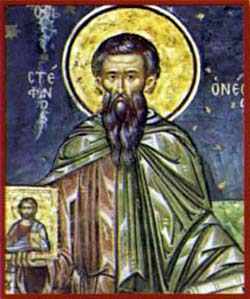 St. Stephen the Younger, Monk, Eastern Martyr
St. Stephen the Younger, Monk, Eastern Martyr
Constantinople, 715 – November 28, 764
A Monk of the East, he lived in the eighth century, during the iconoclast period, of which he was a victim and Martyr. Born in Constantinople in 715, Stephen began at first under the direction of a hermit, then entered the monastery of Monte Sant’Aussenzio in Bithynia, where he became Aabbot. Here he lived, praying and doing the job of copying texts. At that time the emperor Constantine Copronymo, the iconoclast in his battle against the sacred images, had aimed particularly at the monks. Following the council of Hiera, which in 753 condemned the defenders of icons, Stephen openly sided against the emperor. This cost him long harassment, imprisonment and abuse. On November 28, 764 Stephen was killed by some officers of the palace at Constantinople, without the order of the emperor.
Read the rest of this entry »
 Leave a Comment » |
Leave a Comment » |  Martyr, Monks, Religious and Martyr |
Martyr, Monks, Religious and Martyr |  Permalink
Permalink
 Posted by naniam
Posted by naniam
November 27, 2009
On this Eve of Black Friday, it turns out that there are people who don’t worship at the altar of the retail gods the day after Thanksgiving.
What I find striking about this article, coming from the Catholic tradition, in which Mass is available every day of the week, is that the Unitarians have to have a special service on Black Friday. They have nothing scheduled otherwise. Apparently they just go to church on Sunday and call it good.
Granted, I live in a historically Catholic area, and there are churches with Mass in the morning, convenient for people before work; but there’s a church three blocks from my workplace with 12:10 Mass every day. And there are several in the area with 5:15 pm daily Mass. Sometimes, like Thanksgiving, the schedule is curtailed, and there’s only one Mass and no Confession.
Tomorrow? Many churches with daily Mass will be on their regular schedule. If not? The Cathedral where I live is on its regular schedule. I bet the Basilica is too. If you need a respite from extreme shopping, there’s a Catholic Church near you with Mass, Confession and Adoration.
 Leave a Comment » |
Leave a Comment » |  Mass, Materialism |
Mass, Materialism |  Permalink
Permalink
 Posted by naniam
Posted by naniam
November 27, 2009
Saint Bernardine of Fossa, Franciscan Priest
Fossa (L’Aquila), 1421 – L’Aquila, November 27, 1503
Of the Order of Friars Minor, historian and ascetical writer, b. at Fossa, in the Diocese of Aquila, Italy, in 1420; d. at Aquila, 27 November, 1503. Blessed Bernardine belonged to the ancient and noble family of the Amici, and sometimes bears the name of Aquilanus on account of his long residence and death in the town of Aquila. He received his early training at Aquila and thence went to Perugia to study canon and civil law.
On the 12th of March in the year 1445, he received the Seraphic habit from St. James of the Marches who was then preaching a course of Lenten sermons at Perugia. From the time of his entrance into religion, Bernardine never ceased to advance in religious perfection, and the success which crowned his missionary labours throughout Italy, as well as in Dalmatia and Serigonia, bears witness to the eminent sanctity of his life. Bernardine fulfilled the office of provincial of the province of St. Bernardine and of the province of Dalmatia and Bosnia, and would have been chosen Bishop of Aquila had not his humility forbidden him to accept this dignity.
His cult was approved by Leo XII, 26 March, 1828. His feast is kept in the Franciscan Order on the 7th of November. The writings of Blessed Bernardine include several sermons and divers ascetical and historical opuscules; among the latter, the “Chronica Fratrum Minorum Observantiae” deserves special mention. This interesting chronicle was first edited by Leonard Lemmens, O.F.M., from the autograph manuscript, and is prefaced by an interesting life of Blessed Bernardine and a critical estimate of his writings. It may also be mentioned that Bernardine is the author of the first life of his patron, St. Bernardine of Siena.
Source: Catholic Encyclopedia
 Leave a Comment » |
Leave a Comment » |  Beatified by Leo XIII, Beatified Priest, Franciscan, Year for Priests |
Beatified by Leo XIII, Beatified Priest, Franciscan, Year for Priests |  Permalink
Permalink
 Posted by naniam
Posted by naniam
November 26, 2009
 Saint Leonardo de Porto Maurizio, Priest
Saint Leonardo de Porto Maurizio, Priest
Porto Maurizio, Imperia, 1676 – Rome, November 26, 1751
It is this saint to whom we owe the credit for having conceived the Via Crucis. Ligure (1676-1751), was the son of a sea captain. Born in Porto Maurizio, Imperia today, he studied in Rome at the Collegio Romano, then entered the retirement of St. Bonaventure, on the Palatine Hill, where he would wear the Franciscan habit. Posted in Corsica by the Pope to restore harmony among the citizens, he was able to obtain, despite the serious divisions among the inhabitants, an unthinkable embrace. The theme of the Cross was at the center of his preaching drew crowds to repentance and Christian piety. Alfonso Maria de Liguori called him “the greatest missionary of our century.”
Roman Martyrology: In Rome in the convent of Saint Bonaventura on the Palatine Hill, St. Leonard of Port Maurice, Priest of the Order of Friars Minor, who, full of love for souls, engaged all his life in preaching, in publishing books of devotion and to visit in over three hundred missions in Rome, Corsica and Northern Italy.
Young Franciscan Leonardo had asked to be a missionary in China. Cardinal Colloredo had replied: “Your China will be Italy.”
And at the end of the seventeenth century, Italy had enough misery and misfortune enough to be considered mission territory.
Leonardo was a student in Rome, when a friend suggested going to hear a sermon. A few steps, they found that a hanged man dangling from the gallows. “This is the sermon,” said the two young men.
A few days later, the son of a sea captain of Porto Maurizio, Liguria, followed by two figures of monks who climbed to the convent of San Bonaventura on the Palatine Hill, where he donned the habit of the Franciscans called “the riformella” or “displaced” .
Devoting himself to preaching, perhaps remembering that torture hanging from the gallows, including Leonardo was always in mind the other execution, hanging on the Cross. Therefore, his favorite theme was that of the Via Crucis, typically Franciscan devotion to which he gave the largest spread.
His preaching had something dramatic and tragic, often by torchlight and voluntary torture, which underwent between Leonardo, now placing his hand on the torch lit, now scourging blood.
Immense crowds flocked to hear him and be impressed by his fiery speech, which re-called to repentance and Christian piety. “He is the greatest missionary of our century,”said St. Alphonsus de Liguori. Often, the entire audience, during his sermons, burst into sobs.
He preached throughout Italy, but the region of Tuscany was beaten because of the cold Jansenism, he wanted to fight first of all with the fervor of his heart, then with his themes more effective, namely the Name of Jesus, the Madonna and the Via Crucis.
In a visit to Corsica, the island’s troubled robbers fired their muskets into the air, shouting: “Viva friar Leonardo, long live peace.”
Back in Liguria, was launching a galley, named in his honor, San Leonardo. But he was gravely ill, the sailors said: “The boat is water.”
Consumed by the missionary labors, he was finally recalled to Rome, where, with his impassioned sermons, which also assisted the Pope, he prepared the spiritual climate for the Jubilee of 1750. On that occasion, he planted the Via Crucis at the Colosseum, declaring that place sacred to the martyrs.
Historians have also demonstrated that the Colosseum was never martyred Christians, but the preaching ~ in good faith – of San Leonardo prevented the further destruction of the monument, hitherto regarded as a quarry of good stone.
It was his last effort. He died the following year, and San Bonaventura al Palatino it took the soldiers to hold back the crowd who wanted to see the Holy priest and take away his relics. “We lose a friend on earth – the Pope Lambertini said – but we gain a protector in heaven.”
It was he who suggested the definition of the Marian dogma of the Immaculate Conception, through consultation letters with all the pastors of the Church.
Source: Parish Archives
Note: The site of the Compagnia di San Leonardo da Porto Maurizio
source: Santi e Beati
 5 Comments |
5 Comments |  Canonized Priests, Franciscan, Priest, Year for Priests |
Canonized Priests, Franciscan, Priest, Year for Priests |  Permalink
Permalink
 Posted by naniam
Posted by naniam
November 25, 2009
———————————————-
NOTE TO READERS: If you have any suggestions for orders or communities you feel should be highlighted for TCB’s “Vocations Tuesday” please Contact us! @ ASimpleSinner@gmail.com! Include “VOCATIONS TUESDAY” in the subject line please!
 Leave a Comment » |
Leave a Comment » |  Catholic, Christian, Religion, Vocations, Vocations Tuesday | Tagged: Catholic, Christian, Religion, Society of Saint Vincent Ferrier, Vocations, Vocations Tuesday |
Catholic, Christian, Religion, Vocations, Vocations Tuesday | Tagged: Catholic, Christian, Religion, Society of Saint Vincent Ferrier, Vocations, Vocations Tuesday |  Permalink
Permalink
 Posted by asimplesinner
Posted by asimplesinner
November 25, 2009
 Blessed Giacomo Meseguer Burillo, Dominican Priest, Martyr
Blessed Giacomo Meseguer Burillo, Dominican Priest, Martyr
Híjar Meseguer Burillo (Teruel), Spain, 1 May 1885-Barcelona, Spain, date unknown
Roman Martyrology: The blessed Martyr Giacomo Meseguer Burillo, a Dominican Priest, who, in Barcelona, on a day remaining unknown, completed test to the glorious Christ.
He was Beatified on March 11, 2001, together with 232 others, a group known as Blessed Spanish Dominicans of Aragon.
source: Santi e Beati
~~~
Note: other sources name him Santiago. I don’t know which is right. I don’t know where he was buried. I don’t know when he died. I would love to have more information.
Please join me in praying for the repose of his soul.
 1 Comment |
1 Comment |  Beatified by John Paul II, Beatified Priest, Dominican, Martyr of Spain, Priest and Martyr, Religious and Martyr, Year for Priests |
Beatified by John Paul II, Beatified Priest, Dominican, Martyr of Spain, Priest and Martyr, Religious and Martyr, Year for Priests |  Permalink
Permalink
 Posted by naniam
Posted by naniam
November 24, 2009

Blessed Louis de la Pena, Priest, Martyr, Mercedario
+ November 24, 1599
Of Chilean origin, Blessed Louis de la Pena received his Mercedarian religious training in Chile, professing before the year 1578. Ordained a priest, he held various offices in his province, especially evangelize Araucans and was Commendatore of the convent of Valdivia. In an attack Araucans warriors who entered the night in the convent, Father Luig, awakened after the other men, went down in the church and ate the consecrated hosts, to prevent them from being desecrated. He still had the ciborium in his hand, when the warriors came to the church and killed him with blows of lance and looking for the Blessed Sacrament, they opened his chest and tore his heart out. It was November 24 1599, where his body was burned in the fire of the church and he is considered a Martyr of the Eucharist.
The Order celebrates him on November 24.
source: Santi e Beati
 1 Comment |
1 Comment |  Beatified Priest, Martyr of the Eucharist, Priest and Martyr, Religious and Martyr, Year for Priests |
Beatified Priest, Martyr of the Eucharist, Priest and Martyr, Religious and Martyr, Year for Priests |  Permalink
Permalink
 Posted by naniam
Posted by naniam
November 23, 2009
 Blessed Miguel Augustin Pro Jesuit Martyr
Blessed Miguel Augustin Pro Jesuit Martyr
November 23
Guadeloupe, January 13, 1891 – Mexico City, November 23, 1927
Born in Guadeloupe in 1891, he entered the Society of Jesus in 1911, after two of his sisters had taken the veil. He studied in Nicaragua, Spain and Belgium, where he was ordained a priest in 1925. Back in Mexico, he carried out his mission in a period of persecution against the Church. In 1927 he was wrongly accused of being part of a plot to kill a general candidate for president. After a farcical trial, he was shot. To his funeral, defying prohibitions, rushed 20 thousand people. He was beatified on September 25, 1988 by Pope John Paul II, together with other Mexican Martyrs of Persecution. Read the rest of this entry »
 Leave a Comment » |
Leave a Comment » |  Beatified by John Paul II, Beatified Priest, Jesuits, Martyr of Mexico, Priest and Martyr, Religious and Martyr, Year for Priests |
Beatified by John Paul II, Beatified Priest, Jesuits, Martyr of Mexico, Priest and Martyr, Religious and Martyr, Year for Priests |  Permalink
Permalink
 Posted by naniam
Posted by naniam
November 23, 2009
As we head into the week of Thanksgiving, with lots of food and travel, immediately followed by a black Friday shopping frenzy, a columnist poses the question, “What would Jesus buy?”
There are a couple of groups out there that advocate against consumerism. While I’m no longer the shopper that I was, and have pared down my gift list considerably, I can’t imagine that many people will be able to avoid the big box stores or will think to shop locally.
In my area, “locally” could arguably include several big box retailers headquartered here. And a lot of people rely on incomes derived from working either at HQ or in retail stores. In fact, one of my friends just completed several months as a temp at one of the HQ’s. She loved it and hopes to become an employee.
Since I want a new electronic item, I’m likely to shop at a big box store. Soon, because after Thanksgiving, I’m not likely to want to venture to them.
There are a lot of great local stores though, in particular a couple of gift shops; I won’t say they’re chains, but each has several locations. I have no information on the religious or political stance of the owners but do know that if I’m at a loss for what to buy, either of these places will have something fun, appropriate and not seen everywhere. I sometimes go window shopping when I don’t need a gift, just to see what’s new.
One place to shop locally, for icons, is at the Carmelite Monastery. Another, for books on theology, saints and other religious topics, is Loome’s. There are also several religious goods stores in the area, some of which have more than one location.
Our local Little Sisters of the Poor have a holiday boutique with crafts, gift baskets and baked goods. You can also support your parish by supporting its gift shop. Or gift case.
I don’t know what Jesus would buy, but I doubt he’d go into a shopping frenzy.
 Leave a Comment » |
Leave a Comment » |  Catholic |
Catholic |  Permalink
Permalink
 Posted by naniam
Posted by naniam
November 22, 2009
I guess this means Rep. Kennedy isn’t as Catholic as anyone. NO communion for you in my diocese, due to your public stance that’s against Catholic teaching.
Go Bishop Tobin!
 1 Comment |
1 Comment |  Catholic, Eucharist |
Catholic, Eucharist |  Permalink
Permalink
 Posted by naniam
Posted by naniam
November 22, 2009

St. Peter Ramirez Esqueda, Priest and Martyr
San Juan de los Lagos, Mexico, April 29, 1887 – Teocaltitlán, Mexico, November 22, 1927
He was born in Mexico in San Juan de los Lagos, Jalisco (Diocese de San Juan de los Lagos) April 29, 1887. As a priest he devoted himself with special care and passion to the catechesis of children. He founded various centers of study and a school for the catechetical formation. When he was in prison he was beaten so severely that a wound opened on his face. A soldier, after hitting him, said, “Now you will be sorry that you are a priest.” But Father Pedro answered, “No, not even a moment, and I miss just watching the sky.” On November 22, 1927 they pulled him out of jail for justice, children surrounded him and father Esqueda repeated insistently: “Do not neglect to study the catechism, nor any reason to leave out the Christian doctrine.” They three shots were fired. He is remembered along with the Mexican saints and martyrs of the twentieth century.
Roman Martyrology: In the city of Teocaltitlán in Mexico, St. Peter Esqueda Ramírez, Priest and Martyr, who, during the persecution in Mexico was thrown into prison for his priesthood, and finally shot.
The 25 Mexican Martyred Saints (Christopher Magallanes Jara and 24 fellows), by the will of John Paul II, immediately after Canonization, were placed in the Roman Calendar on May 21 as an optional memorial. The Martyrologium Romanum commemorates each Saint and Blessed separately, each on the anniversary of martyrdom.
source: Santi e Beati
 5 Comments |
5 Comments |  Canonized Priests, Martyr of Mexico, Priest and Martyr, Year for Priests |
Canonized Priests, Martyr of Mexico, Priest and Martyr, Year for Priests |  Permalink
Permalink
 Posted by naniam
Posted by naniam
November 21, 2009
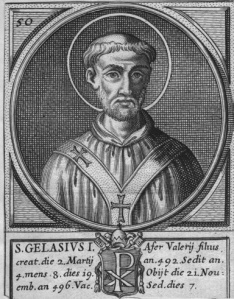 Pope St. Gelasius I (image source)
Pope St. Gelasius I (image source)
November 21
Gelasius was born in Rome, in the fifth century, the son of an African named Valerius. Later, ordained a priest, he was elected Pope on March 1st, 492. Gelasius had a reputation for learning, justice, holiness, and charity. However, he was burdened with difficulties caused by a conflict with Euphemius, the Patriarch of Constantinople, over the Acacian heresy. He also protested the encroachments by Constantinople on Alexandria and Antioch. Gelasius was influential in setting aside Roman pagan festivals. Moreover, in opposition to the Manichaeans, he ordered reception of the Eucharist under both species. Gelasius is known to have composed liturgical Prefaces and Orations for Sacramentaries, which may be part of the Leonine Sacramentary. However, he had nothing to do with the Gelasian Sacramentary or the Gelasian Decree (listing the Canonical books of the Bible) – which have been erroneously attributed to him. He died at Rome on November 21, 496.
Source: Saints & Angels
 3 Comments |
3 Comments |  Eucharist, Pope, Year for Priests |
Eucharist, Pope, Year for Priests |  Permalink
Permalink
 Posted by naniam
Posted by naniam
November 20, 2009
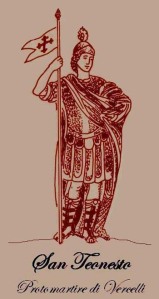
Saint Teonesto, Martyr in Vercelli
November 20
Teonesto was a member of the primitive Christian community of Vercelli, the previous bishop of Eusebius, and perhaps even peace of Constantine, who testified at the sacrifice of his life for his faith. After the martyrdom, his body was buried in a cemetery area where Christian and pagan remains were located, without particular distinction. It would appear that Eusebius himself erected the chapel in which lie the remains of the saint, which was enlarged and transformed by the end of the fourth century into the first Basilica Eusebiana. Today the saint’s relics are kept in a niche above the altar of Our Lady placed the slap in the cathedral of Vercelli.
Read the rest of this entry »
 Leave a Comment » |
Leave a Comment » |  Martyr |
Martyr |  Permalink
Permalink
 Posted by naniam
Posted by naniam
November 19, 2009
 Saint Simon, Abate of Calabria
Saint Simon, Abate of Calabria
Roman Martyrology: The Mercury massif in Calabria, San Simone, hermit.
Calabrian saint venerated in the East. By an abbot of a monastery in Calabria unidentified, he was sent to Africa to secure the release of some monks, captured and taken to Africa by the Arabs. From one of the hostages, Simon knew that at any price they wanted to make them renounce their Christian faith, they refused, the Saracens wanted to hit, but suddenly his arm was paralyzed. Pity, the Holy healed them obtain, after this miracle, the head of the Arabs, the release of all the monks. Back in Calabria, Simon led the life of a hermit.
source: Santi e Beati
 Comments Off on Saint Simon, November 19 |
Comments Off on Saint Simon, November 19 |  Catholic, Hermit, saint |
Catholic, Hermit, saint |  Permalink
Permalink
 Posted by naniam
Posted by naniam
November 18, 2009
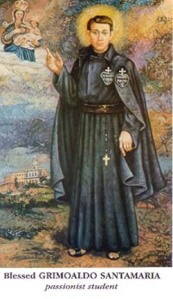
Blessed Grimoaldo of the Purification (Ferdinand Santamaria)
Pontecorvo (FR), 4 May 1883 – Ceccano (FR), November 18, 1902
Purification of the Blessed Grimoaldo (born Ferdinand Santamaria) was born in Pontecorvo (FR) on 4 May 1883, he entered the novitiate of the Passionist in Paliano (FR) February 16, 1899, where he made a profession of temporary vows March 6, 1900 and died prematurely for acute meningitis in the Passionist monastery in Cecco (FR) on 18 November 1902. John Paul II declared him “venerable” on 14 May 1991 and “blessed” January 29, 1995. The remains of Blessed Grimoaldo are venerated in the church of Passionist Abbey Ceccano. Read the rest of this entry »
 Leave a Comment » |
Leave a Comment » |  Passionist, Year for Priests |
Passionist, Year for Priests |  Permalink
Permalink
 Posted by naniam
Posted by naniam
November 17, 2009
Serbian Orthodox Patriarch Pavle Dies At 95

Patriarch Pavle prays at Serbian Orthodox Christmas liturgy in Belgrade in January 2007.
November 15, 2009
BELGRADE — The head of the Serbian Orthodox Church, 95-year-old Patriarch Pavle, has died after a lengthy battle with age-related illness,
RFE/RL’s Balkan Service reports.His death ends nearly two decades of leadership that spanned one of the most painful chapters in Serbian history.
His rise to the patriarchate in 1990 — soon after Slobodan Milosevic had become president of an increasingly divided Yugoslavia — placed Pavle in the eye of a gathering storm. Pavle’s tenure as patriarch sparked fierce disputes over the actions of the Church as nationalist and ethnic conflagrations spread through the Balkans.
Read the rest of this entry »
 Leave a Comment » |
Leave a Comment » |  Orthodox, Orthodox Church |
Orthodox, Orthodox Church |  Permalink
Permalink
 Posted by naniam
Posted by naniam
November 17, 2009
 Saint Giordano Ansalone, Dominican Priest, Martyr
Saint Giordano Ansalone, Dominican Priest, Martyr
Santo Stefano Quisquina (Agrigento), 1 November 1598 – Nagasaki (Japan), November 17, 1634
In 1625, he reached Seville on foot, he left for the missions. After a break of about a year in Mexico, across the Pacific in the summer of 1626, he reached the Philippine Islands. First two years costs between the Philippines, Cagayan in northern Luzon, then lived for four years among the Chinese of a colony of the suburb of Binondo, Manila, in the Parish and the Hospital S. Gabriel, built for them. Studied the language, the mentality and customs from the Chinese, showing true forerunner of inculturation and dialogue with non-believers. To do this he also wrote an opera, hopelessly lost, which compiled the main religious beliefs and philosophical ideas of the Chinese, discussing them with the data of faith and Catholic doctrine, for an enlightening comparison. In 1632, the midst of this persecution, he went to Japan, disguised as a merchant, to bring aid and comfort: for a year he was the Vicar Provincial of this mission. Seriously ill on the island of Kyushu, “he implored the Virgin Mary to be cured until they had killed Christ.” He was jailed August 4, 1634 and subjected to unspeakable torture.
source: Santi e Beati
 2 Comments |
2 Comments |  Canonized Priests, Dominican, Martyrs of Japan, Religious and Martyr, Year for Priests |
Canonized Priests, Dominican, Martyrs of Japan, Religious and Martyr, Year for Priests |  Permalink
Permalink
 Posted by naniam
Posted by naniam
November 16, 2009
 image source
image source
Blessed Edward Osbaldeston, Martyr
November 16
Roman Martyrology: At York in England, Blessed Edward Osbaldeston, priest and martyr of Lancaster, who, a student of English College of Rheims, who was sentenced to death under Queen Elizabeth I came to be a priest in England, died hanged.
source: Santi e Beati
 1 Comment |
1 Comment |  Beatified Priest, Martyr, Martyr Of England, Priest and Martyr, Year for Priests |
Beatified Priest, Martyr, Martyr Of England, Priest and Martyr, Year for Priests |  Permalink
Permalink
 Posted by naniam
Posted by naniam
November 15, 2009

Blessed Hugh Faringdon (Cook), John Eynon and John Rugg Martyrs
m. Reading, United Kingdom, November 15, 1539
The Martyrologium Romanum commemorates today the three Benedictine Blessed Hugh Faringdon (Cook), Abbot of Reading, John Eynon and John Ruggie, Priests. Tenaciously opposed to the claims of King Henry VIII of England within the spiritual domain and therefore were falsely accused of conspiracy. Front of the monastery were then hanged and then horribly gutted. Pope Leo XIII beatified them on May 13, 1895.
Roman Martyrology: At Reading in Britain, Martyrs Hugh Cook Faringdon, Abbot of the Order of St. Benedict, John Eynon and John Ruggie, Priests who were accused of treason for being fiercely opposed to the claims of primacy in the Church of King Henry VIII died hanged and disemboweled with a sword in front of the monastery.
In 1534 the English clergy was called to take an oath of supremacy recognizing the monarch as head of the English Church in the territory of the kingdom. With the exception of Saints Thomas More and John Fisher, the Carthusian monks and Observant Franciscans, a few others immediately objected to this betrayal of the pope. The abbots of Glastonbury, Reading and Colchester all lent oath with their monks, hoping to thereby protect their ancient monasteries from the tyranny of kings, but all three reached a point of no return when it intensified the suppression of monastic orders.
The Abbot of Reading, Hugh Faringdon was commonly called by the name of his county of origin and his nickname was Cook. In this abbey he became Monaco and was elected abbot in 1250, very high office that entitled the holder to a seat in the House of Lords and the Council, as the magistrate of the county. The reporters called him a man hostile to him “completely without culture,” yet the teacher of elementary school in Reading dedicated a book to him even in rhetoric. Hugh also managed to enforce discipline in his monastery excellent.
Strongly opposed the preachers of new doctrines Protestants, whom he described as “heretics and scoundrels, but was on good terms with King Henry VIII, perhaps for convenience, given the proximity between the Abbey and Windsor. They used to exchange visits and gifts. Hugh also tried in vain to help the King to obtain from the Pope the annulment of the marriage to Catherine of Aragon, by signing the letter of request. In 1536, also signed the Act of Supremacy and the following year still enjoyed the sympathy of the king, as he held an important role in the funeral of Queen Jane Seymour.
A few weeks later, a diplomatic incident occurred: Abbot Hugh offended the sovereign, spread the false news of his death. He wuestioned by a committee, but was later released. After he was taken to the suppression of monastic orders, as Hugh does not accept this soppruso summer of 1539 he was imprisoned in the Tower of London, accused of treason. With him were tried John Eynon, a priest of the church of St Giles in Reading, and John Ruggie, the prebend of Chichester, who had retired in the abbey of Reading. The former was accused of having written and distributed a copy of the Pilgrimage of Grace in 1536, while the latter possessed a relic of the hands of Saint Anastasius, while knowing that his majesty had sent inspectors in the said abbey to put an end to the idolatry . However, there is certainty that these two priests were Benedictine monks.
Terms prosecuting coinvoltse all three are unknown, but easily imaginable. Abbot Hugh spoke very clearly on the gallows in his opinion the supremacy of the Holy See in spiritual matters was “the common faith of those who had the right to declare the true teachings of the English Church.” Their execution took place outside the abbey of Reading November 15, 1539.
Hugh Faringdon (Cook), abbot of Reading, John Eynon and John Rugg were Beatified by Pope Leo XIII, May 13, 1895 by confirmation of their cults.
Author: Fabio Arduino
Source: Santi e Beati
 2 Comments |
2 Comments |  Beatified Abbott, Beatified by Leo XIII, Beatified Priest, Benedictines, English Martyrs, Priest and Martyr, Religious and Martyr, Year for Priests |
Beatified Abbott, Beatified by Leo XIII, Beatified Priest, Benedictines, English Martyrs, Priest and Martyr, Religious and Martyr, Year for Priests |  Permalink
Permalink
 Posted by naniam
Posted by naniam
November 14, 2009
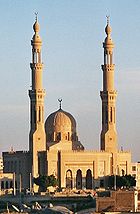 source
source
I’m sure you’ve read about government seizure of a building in New York City, together with a few mosques around the country. There’s a private Muslim school in the building, which receives support from the Alavi Foundation, the foundation which is tied to Iran, from which the buildings have been seized.
Now people associated with the school are concerned about being tainted. It’s perfectly reasonable for them to be concerned; their space is in a building owned by a foundation with financial ties that are counter to American law. In addition, they’re supported by that same foundation, so yeah, they’re suspect.
Keep in mind that most Amerians could care less, and that the only actual backlash about which I’m aware related to the Fort Hood Jihadist, is that a Greek Orthodox Priest in Florida was attacked by an idiot who claimed he was a jihadist and yelled Allah Akbar. Good trick for a guy who doesn’t speak Arabic.
 Leave a Comment » |
Leave a Comment » |  Islamic Threat, Jihad, Muslim |
Islamic Threat, Jihad, Muslim |  Permalink
Permalink
 Posted by naniam
Posted by naniam
November 14, 2009
 photo source
photo source
Last Saturday I drove up to Alexandria, to pray at Father Didier’s grave. It’s about a 2 1/2 hour drive from where I live, and it was a beautiful day for a drive. I mapquested the cemetery but had been unable to find information about the location of his grave. The cemetery is easy to find and pretty small.
As you can see in the photo of his parents, from the Echo Press, his grave is by the road in the cemetery; I was looking for the item in the left front of the photo, which houses a guestbook, pens and prayer cards. I saw a rosary and a bunch of individual notes in there as well.
What isn’t shown in the photo, to the left and right of the pillar, is a matching park bench, made of stone. One is opposite Father’s grave, the other opposite the graves of family members. Since I had parked coming in to the cemetery I didn’t see the Body and Blood of Christ depicted on the pillar.
I sat on the bench opposite his grave and prayed for the poor souls in purgatory, especially souls of priests. I also prayed for some priests I know as well as other intentions and wrote a note related thereto in the guestbook.
I don’t know, and may never know, if he interceded on behalf of anyone or any intention for which I prayed, but in some ways that’s incidental; my greatest motivation was to pray for the souls in purgatory.
 Leave a Comment » |
Leave a Comment » |  Purgatory, Year for Priests |
Purgatory, Year for Priests |  Permalink
Permalink
 Posted by naniam
Posted by naniam
November 14, 2009

Saints Nicholas Tavelic, Stephen of Cuneo, Deodato Aribert from Ruticinio and Peter of Narbonne Franciscan Priests, Martyrs
† Jerusalem, November 14, 1391
Roman Martyrology: In Jerusalem, the Holy Nicholas Tavelic, Deodato Aribert, Stephen of Cuneo and Peter of Narbonne, Priests of the Order of Friars Minor and Martyrs who were burned in the fire for preaching boldly in the public square in front of the Saracens, the Christian religion, professing Strongly Christ Son of God
Read the rest of this entry »
 1 Comment |
1 Comment |  Canonized by Leo XIII, Canonized by Paul VI, Canonized Priests, Catholic History, Franciscans, Islam, Martyrs of Jerusalem, Martyrs Persecution, Mohammetism, Priest and Martyr, Religious and Martyr, Sharia, Year for Priests |
Canonized by Leo XIII, Canonized by Paul VI, Canonized Priests, Catholic History, Franciscans, Islam, Martyrs of Jerusalem, Martyrs Persecution, Mohammetism, Priest and Martyr, Religious and Martyr, Sharia, Year for Priests |  Permalink
Permalink
 Posted by naniam
Posted by naniam
November 13, 2009
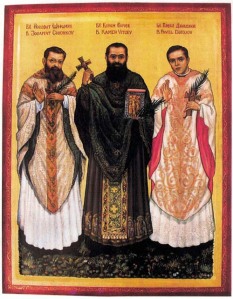
Blessed Pavel Djidjov, Priest and Martyr
Plovdiv, Bulgaria, July 19, 1919 – Sofia, Bulgaria, November 12, 1952
Roman Martyrology: At Sofia, Bulgaria, Blessed Peter Vicev, Pavel (Joseph) Džidžov and Jehoshaphat (Robert Matthew) Shishkov, priests of the Congregation of the Augustinians of the Assumption, who, unjustly accused of treason under an atheist regime and thrown into prison because they were Christians, in their mortal combat deserve to receive the reward of eternity, the faithful disciples of Christ.
Joseph Dzjidzjov was born in the Bulgarian town of Plovdiv July 19, 1919, to a Catholic family in the Latin rite. In 1926 he became a student of School of the Assumption St. Andrew in his native country. From 1931 to 1938 he studied in the College of St. Augustine, in the same city. On February 2, 1938 as a trainee recruit, he finally entered Noseroa, France, and assumed the religious name of Pavel.
He studied philosophy and theology in Lormoa, near Paris, until 1942, when he made his perpetual profession of vows.
Then forced by illness to return to Bulgaria, he continued his theological studies as an irregular student. On January 26, 1945 in Plovdiv, he was ordained a priest in the Latin rite. To Varna he was then sent, to study economics and social sciences, in order to delegations following the various activities relating to housing and economic management of the mission. Father Pavel, a very good student and active, exerted a positive influence on his comrades. With courage, he didn’t hide his anti-communist ideas and beliefs and then, for this reason, was kept firmly under control by the secret services of Bulgaria’s new leadership.
His superiors then entrusted him with the job of treasurer of the College St. Augustine in Plovdiv and later treasurer of the Eastern Vicariate. Constantly followed by the communist militia during the night of July 4, 1952, he was arrested in seminary recruitment of Plovdiv, together with Father Kamen Vicev. Pavel Dzjidjov figured second in the list of complaints.
For him and his brothers Kamen Vitchev and Josaphat Chichkov the death sentence was issued October 3, 1952, and were shot in the night between 11 and November 12, 1952 in Sofia, Bulgarian capital, along with Blessed Bishop Eugenio Bossilkov. The place of their burial in the cemetery of the city has never been discovered. The three priest martyrs were beatified by Pope John Paul II May 26, 2002.
Author: Fabio Arduino
Source: Santi e Beati
 Leave a Comment » |
Leave a Comment » |  Beatified by John Paul II, Beatified Priest, Priest and Martyr, Religious and Martyr, Year for Priests |
Beatified by John Paul II, Beatified Priest, Priest and Martyr, Religious and Martyr, Year for Priests |  Permalink
Permalink
 Posted by naniam
Posted by naniam
November 12, 2009

MARIAN PRAYER OF SAINT GREGORY OF NAREK (A.D. 1010)
Assist me by the wings of your prayers,
O you who are called the Mother of the living,
so that on my exit from this valley of tears
I may be able to advance without torment
to the dwelling of life
that has been prepared for us
to lighten the end of a life burdened by my iniquity.
Healer of the sorrows of Eve,
change my day of anguish into a feast of gladness.
Be my Advocate,
ask and supplicate.
For as I believe in your inexpressible purity,
so do I also believe in
the good reception that is given to your word.
O you who are blessed among women,
help me with your tears
for I am in danger.
Bend the knee to obtain my reconciliation,
O Mother of God.
Be solicitous for me for I am miserable, Read the rest of this entry »
 Leave a Comment » |
Leave a Comment » |  Catholic | Tagged: Blessed Mother, Blessed Virgin Mother, BVM, Catholic, Christian, Christianity, Gregory of Narek, ΘΕΟΤΟΚΟΣ, Marian Prayer, Mary, Our Lady, saint, Saints, Theotokos |
Catholic | Tagged: Blessed Mother, Blessed Virgin Mother, BVM, Catholic, Christian, Christianity, Gregory of Narek, ΘΕΟΤΟΚΟΣ, Marian Prayer, Mary, Our Lady, saint, Saints, Theotokos |  Permalink
Permalink
 Posted by asimplesinner
Posted by asimplesinner
November 12, 2009
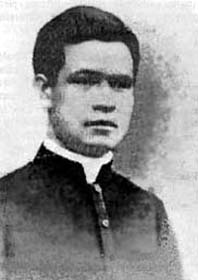
Saint Margarito Flores Garcia, Priest and Martyr
Taxco, Mexico, February 22, 1899 – Tulimán, Mexico, November 12, 1927
He was born in Taxco, Guerrero (Diocese of Chilapa) on February 22, 1899. Pastor of Atenango del Rio, Guerrero (Diocese of Chilapa). His three years in the ministry were enough to know his priestly character. The Vicar General of the Diocese appointed him vicar to act as pastor of Atenango del Rio, Guerrero. Father Margarito set to work. He was discovered and identified as a priest when he was about to reach that goal; he was imprisoned and taken to Tulimán, Guerrero, where orders were given to shoot him. Father Margarito asked permission to pray, he knelt for a moment, kissed the ground and then rose and waited for the shots that destroyed his head and forever united him to Christ the Priest, on November 12, 1927. On May 21, 2000, he was Canonized by Pope John Paul II together with 24 other martyrs of Mexico. The group is known as Christopher Magallanes Jara and 24 companion and is celebrated with an optional Memorial on May 21.Each is celebrated separately, on their martrydom anniversary.
Roman Martyrology: In the city of Tulimán Mexico, Saint Margarito Flores, Priest and Martyr, who, during the great persecution against the Church, was arrested for his priesthood and crowned by glorious martyrdom with the shooting.
Source: Santi e Beati
 1 Comment |
1 Comment |  Beatified by John Paul II, Beatified Priest, Canonized by John Paul II, Martyr, Martyr of Mexico, Martyrs Persecution, Year for Priests |
Beatified by John Paul II, Beatified Priest, Canonized by John Paul II, Martyr, Martyr of Mexico, Martyrs Persecution, Year for Priests |  Permalink
Permalink
 Posted by naniam
Posted by naniam
November 11, 2009
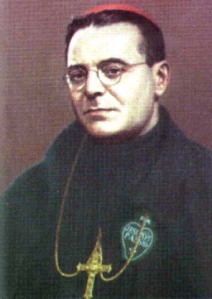
Blessed Vincent Eugene Bossilkov, Passionist Bishop and Martyr
Belene (Bulgaria), November 16, 1900 – Sofia (Bulgaria), November 11, 1952
Vincenzo was born in Belene (Bulgaria) in 1900. His family belonged to the Latin-rite Catholic minority in the Diocese of Nicopolis. At 11 he was sent to Ores, to the school of the Passionist Fathers. Hence his vocation which would be planted with ten years of study in Belgium and Holland. He joined the congregation with the name of Eugene and became a priest in Bulgaria. He then went again to Rome. Returning home he waived all diocesan duties to devote himself to what he feels like his true mission: to explain the cross to the peasants in their language. In 1944 he was appointed Bishop of Nicopolis, in one state (the fledgling People’s Republic of obedience under Stalin) against religion. Still unable to come to Rome in 1948 when asked by Pope Pius XII. Then began the mechanism of seizures, evictions, orders to match a ‘national church’ vassal of a scheme, asked to repudiate the Pope. But Eugene was opposed. This caused his arrest in July 1952, torture, mock trial, death sentence and murder in the prison of Sofia, in secret. His body was thrown into a common grave. Pope John Paul II beatified him on March 15, 1998.
Roman Martyrology: At Sofia, Bulgaria, Blessed Vincent Eugene Bossilkov, Bishop of Nicopolis’ and Martyr of the Congregation of the Passion of Jesus, who, under a tyrannical regime, was led to jail for refusing to renounce communion with Rome and cruelly tortured, was condemned to death on charges of treason and then shot.
Source: Santi e Beati
 2 Comments |
2 Comments |  Beatified by John Paul II, Bishop and Martyr, Martyr of Communism, Martyrs Persecution, Passionist, Religious and Martyr, Year for Priests |
Beatified by John Paul II, Bishop and Martyr, Martyr of Communism, Martyrs Persecution, Passionist, Religious and Martyr, Year for Priests |  Permalink
Permalink
 Posted by naniam
Posted by naniam
November 11, 2009
THE HAGUE, Netherlands- Dutch prosecutors said Tuesday they have arrested a 43-year-old Somali man wanted by U.S. authorities for allegedly financing Islamic extremist terrorists.
Prosecutors said in a statement the man lived in Minneapolis before leaving the United States in November 2008; he arrived in the Netherlands about one month later.
The identity of the man, who was arrested Sunday at an asylum seeker’s center near Amsterdam, was not released in line with Dutch privacy laws. The statement by the national prosecutors office said American authorities asked for the man’s arrest and have sought his extradition.
E.K. Wilson, an FBI spokesman in Minneapolis, said: “We’re aware of this individual and of this arrest, and it is related to our ongoing Minneapolis investigation.” Wilson said the FBI was working closely with Dutch authorities through its legal attache office in Brussels, and is also coordinating with the Department of Justice Office of International Affairs.
As many as 20 young Somali men left the Minneapolis area over the last two years to go to Somalia and possibly fight with terror groups. At least three men have died, including one who carried out a suicide bombing in the semiautonomous Puntland region in October 2008.
Three others have pleaded guilty in federal court in Minneapolis to terror-related charges. A fourth man has pleaded guilty to perjury, and a fifth has pleaded not guilty to lying to the FBI.
The Dutch statement says U.S. prosecutors suspect the man arrested Sunday of bankrolling the purchase of weapons for Islamic extremists and helping other Somalis travel to Somalia in 2007 and 2008.
The suspect was ordered held for 60 days at a hearing Tuesday before an investigating judge in the city of Rotterdam.
Prosecutors did not immediately return after-hours calls seeking more details.
Source
 Leave a Comment » |
Leave a Comment » |  Catholic |
Catholic |  Permalink
Permalink
 Posted by naniam
Posted by naniam
November 10, 2009
St. Probus Bishop of Ravenna
November 10
Roman Martyrology: At Ravenna, St. Probus, Bishop, in whose honor the Bishop St. Maximus the famous basilica dedicated Class.
Probe: a bell’aggettivo, used at least once, even as a name, in the way they are used even today the names of Modesto, Pius, Clement, and Benedict Benigno. Probus means honest, upright, honest: Even today, for every profession, there are the so-called viri honest, that honest men, who judge the correctness of my colleagues in professional life.
The literature records a famous grammarian, Marcus Valerius Probus. Policy, a Roman emperor, Marcus Aurelius Probus, under which the Christians, at least officially, were not persecuted. And Christians should cherish that name that promises fairness and honesty, even in women who took the name of Probus.
Thus, the Christian calendar records a Proba Holy Virgin and Martyr, April 28, another Santa Proba, also Virgin and Martyr, 30 April. Among the Saints Probe is a venerable Bishop of Verona, the fourth century, January 12, a bishop of Rieti mentioned in the Dialogues of St. Gregory the Great, March 15.
On April 5, the couple are remembered even exemplary Christians in the name, Probus and Grace. Finally, today is the feast of St. Probus, Bishop of Ravenna, or better than Class as a class, the military port of Ravenna, came the early Christians, who had the first cemetery in which buried Apollinaris, sent by St. Peter, According to tradition, to evangelize the Adriatic coast.
The tomb of the first bishop of Ravenna was built then the basilica of St Apollinaris in Classe, splendid mosaics which still arouse admiration surprised. And great the images in the mosaics of the immediate suc-mold of Sant’Apollinare: Ecclesia, Severo, Bear and Ursicinus. If the series had been continued after the bears would come lambs. And it is the Bishop Lamb, of the IX century, speaking of the apostolic tradition of Ravenna, mentions two bishops named Probus. The first was the seventh of the series, the second the fourteenth.
“The holy soul of Probus – says the Bishop Lamb – November 10 left his body.
And behind the statement of Bishop Lamb, that historical criticism can neither confirm nor deny, is remembered today that Bishop, in name and upright life, and so holy as probity and sanctity are mixed in the figures of shepherds were an example of fairness and virtue to the whole flock entrusted to their care.
Source: Parish Archives
Source: Santi e Beati
 Leave a Comment » |
Leave a Comment » |  Canonized Bishop, Year for Priests |
Canonized Bishop, Year for Priests |  Permalink
Permalink
 Posted by naniam
Posted by naniam
November 9, 2009
In the 60’s and 70’s, the beginning of the Radical Dissident Catholic Era, many priests were laicized and got married. In fact, many of them married former nuns. While I have only personally been acquainted (that I know of) with one laicized priest, he wasn’t someone who should’ve been ordained. He had the same sort of wardrobe malfunction that Ted Kennedy had. I believe it was intended as a way out. In his case it was successful.
Now that the personal ordinariate for Anglicans has been announced, The Washington Post thinks that celibacy for Roman Catholic Priests is on its way out. What impressed me about the article is that they do point out that Eastern Catholics ordain married men but that priests aren’t married; most people assume that priests may marry after ordination. Eastern Catholic Churches in the US typically ordain only celibate men. Eastern Catholic Bishops are always celibate as are Orthodox Bishops.
I disagree with the Washington Post; Anglicans have made many changes since the church of England was formed, including allowing priests to be married before or after ordination. Eastern Catholics, formerly Orthodox, were brought into Communion with Rome while retaining their traditions, traditions that had existed at the time of the Great Schism, including the Ordination of married men. The difference here is that a married priesthood in the Latin Rite Catholic Church did not exist at the time the Anglicans left and while married men in the Eastern Catholic Churches and the Orthodox Church may be Ordained, priests may not marry after ordination. While it’s certainly possible that the Church would decide to allow married men to be Ordained within the Anglican Personal Ordinariate, I would be very surprised if she would allow priests to get married or allow a married Priesthood in the Latin Rite.
 3 Comments |
3 Comments |  Anglican, Anglican Communion, Benedict XVI, Byzantine Catholic, Catholic, Convert, Roman Catholic Church, Rome, TAC |
Anglican, Anglican Communion, Benedict XVI, Byzantine Catholic, Catholic, Convert, Roman Catholic Church, Rome, TAC |  Permalink
Permalink
 Posted by naniam
Posted by naniam
November 9, 2009

Blessed Henryk Hlebowicz, Priest and Martyr
Grond, Poland, June 1, 1904 – Borysów, Poland, November 9, 1941
Blessed Henryk Hlebowicz, Polish Diocesan Priest, was born in Grondo on June 1, 1904, died in Borysów November 9, 1941. He was Beatified by Pope John Paul II in Warsaw (Poland) June 13, 1999, together with 107 other Polish martyrs.
Roman Martyrology: In the town of Borysów in Poland, blessed Henry Hlebowicz, Priest and Martyr, shot during the war in hatred of the faith.
Source: Santi e Beati
 1 Comment |
1 Comment |  Beatified by John Paul II, Diocesan Priest Martyr, Polish Martyr, Priest and Martyr, Year for Priests |
Beatified by John Paul II, Diocesan Priest Martyr, Polish Martyr, Priest and Martyr, Year for Priests |  Permalink
Permalink
 Posted by naniam
Posted by naniam
November 8, 2009
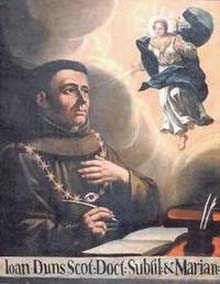 Blessed John Duns Scotus
Blessed John Duns Scotus
ca. 1265, Scotland – Cologne, November 8, 1308
Born between December 23, 1265 and March 17, 1266, in Scotland, hence the nickname “Scot.” His birthplace, Duns, bore name of his family. As a child, hw came into contact with the Franciscans, with whome he began studying at thirteen, in the recluse of Haddington, County Berwich. After completing his studies in theology he was devoted to teaching, first at Oxford, then in Paris and Cologne. Here, on behalf of the general of his congregation, he had to deal with the heretical doctrines, but managed to concentrate for a short time the firm. He died a few months after his arrival, on November 8, 1308. John Duns is considered one of the greatest masters of Christian theology and is the precursor of the doctrine of the Immaculate Conception. John Paul II Beatified him on March 20, 1993 calling him “the bard of the Incarnate Word and defender of the Immaculate conception of Mary.” His mortal remains are kept in the church of the Friars Minor of Cologne.
Roman Martyrology: In Cologne, in Lorraine, now in Germany, Blessed John Duns Scotus, a priest of the Order of Minors, which, of Scottish descent, master distinguished for subtlety of wit and admirable piety, he taught philosophy and theology in schools in Canterbury, Oxford , Paris and Cologne.
Source: Santi e Beati
 Leave a Comment » |
Leave a Comment » |  Beatified by John Paul II, Beatified Priest, Franciscan, Year for Priests |
Beatified by John Paul II, Beatified Priest, Franciscan, Year for Priests |  Permalink
Permalink
 Posted by naniam
Posted by naniam
November 7, 2009

Here’s an interesting article about a priest who hunts. He grew up in a family that hunted, which is typical in Minnesota; we rank 5th in state for number of hunters. There’s really no reason to think about the morality of hunting, as it’s what people do here.
This particular priest is in a rural area, so of course they hunt.
Read the article.
It’s deerhunting season.
 Leave a Comment » |
Leave a Comment » |  Morality, Priest, Year for Priests |
Morality, Priest, Year for Priests |  Permalink
Permalink
 Posted by naniam
Posted by naniam
November 7, 2009
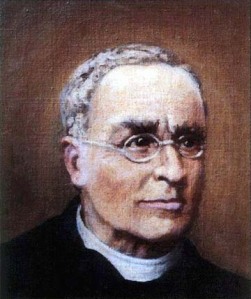
Blessed Vincenzo Grossi, Priest
Pizzighettone, Cremona, March 9, 1845 – November 7, 1917
Blessed Vincent Grossi was born March 9, 1845 in Pizzighettone (CR): next to last of seven brothers. In 1866 he entered the seminary of Cremona and was ordained May 22, 1869. First he was commissioned to curate in several parishes, then a parish priest in 1873 and in 1883 he went to Regona Vicobellignano.
He had… for all the illustrious example of poverty, a spirit of self-denial, austere life, totally subservient obedience to the Pope and his bishop. So with gentleness, combined with a usual good humor and geniality – which recommended warmly to his sisters – are easily won over the confidence of many to win for Jesus Christ.
In 1885 he founded the Institute of the Daughters of the Oratory, giving rules in the spirit of St. Philip Blacks and the charisma of the Christian education of youth. He died November 7, 1917, when we celebrate the liturgical memorial. Read the rest of this entry »
 1 Comment |
1 Comment |  Beatified by Pope Paul VI, Beatified Priest, Founder, Priest, Year for Priests |
Beatified by Pope Paul VI, Beatified Priest, Founder, Priest, Year for Priests |  Permalink
Permalink
 Posted by naniam
Posted by naniam
November 6, 2009

Blessed Thomas Jihyoe of St. Augustine,Augustinian, Priest, Martyr
Nagasaki, Japan, 1600 – November 6, 1637
Thomas Jihyoe, Augustinian Japanese, during the anti-Christian persecution during the seventeenth century, for 5 years with the nom de guerre “Kintsuba” held in check the soldiers of the emperor who tried to capture him because he was Catholic.He was born in Omura, Nagasaki around 1600, his parents were both catechists and died martyrs for the faith. As a child he attended the Jesuit school in Arima, but the school was closed because of persecution so he went to Macao to finish his studies. On an Augustinian missionary, since 1622, he moved to Manila in the Philippines and made his religious profession in the convent of St. Augustine Intramuros in 1624, then to Cebu to take up his theological studies. On completion of training he was ordained to the Priesthood. In the meantime persecution raged in Japan and the missionaries were falling one by one under the relentless blows of the persecutors, leaving the Catholic communities abandoned. Thomas felt that his place was in his country and, after several attempts, followed by as many shipwrecks, in 1631 was able to return to Nagasaki. Read the rest of this entry »
 Leave a Comment » |
Leave a Comment » |  Augustinian, Beatified by Benedict XVI, Beatified Priest, Martyr, Martyrs of Japan, Priest and Martyr, Religious and Martyr, Year for Priests |
Augustinian, Beatified by Benedict XVI, Beatified Priest, Martyr, Martyrs of Japan, Priest and Martyr, Religious and Martyr, Year for Priests |  Permalink
Permalink
 Posted by naniam
Posted by naniam
November 5, 2009

Religious leader promotes ‘green’ causes
Washington Post Staff Writer
Tuesday, November 3, 2009 An unusual environmental lobbyist will be making the rounds this week on Capitol Hill: the spiritual leader of the Orthodox Church.
Ecumenical Patriarch Bartholomew, the highest spiritual figure for the world’s 250 million Orthodox Christians, arrived in Washington on Sunday night for a week of lectures and meetings highlighting his interest in environmental health as a religious issue. He is scheduled to meet with President Obama on Tuesday, Vice President Biden and House Speaker Nancy Pelosi (D-Calif.) on Wednesday and Secretary of State Hillary Rodham Clinton on Thursday. Read the rest of this entry »
 Leave a Comment » |
Leave a Comment » |  Barack Obama, East/West, Green, Orthodox, Orthodox Church, Religious Freedom |
Barack Obama, East/West, Green, Orthodox, Orthodox Church, Religious Freedom |  Permalink
Permalink
 Posted by naniam
Posted by naniam
November 5, 2009

San Mamete (Mamet) Confessor
November 5, Auvergne (France), fourth century
His name appears in the “Life III” by Saint Austremonio, bishop of Clermont and first bishop of Auvergne, Massif Central region of France, probably written by St. Gregory of Tours and it classifies him as a companion evangelizer in Auvergne.
Langres (in French Mamet), had to be a priest and was appointed by Saint Austromoine and evangelize the region of the St-Flour. Even today, a village named after him, St-Mamet-le-Salvetat, in the district of Aurillac.
The relics of St. Mamete have disappeared long ago, there is also the doubt that has ever been preserved, not to mention the loss of the relics of many saints at the time of the French Revolution.
His feast day is November 5 in commemoration of all saints of Auvergne, and 17 August in the diocese of St-Flour.
He is the only saint with this name report published in the “Bibliotheca Sanctorum”, and he is not mentioned by the ‘Roman Martyrology’, which instead celebrates November 1 Saint Austromoine with whom he was a partner in evangelizing the Auvergne in the early fourth century.
Author: Antonio Borrelli
Source: Santi e Beati
 Leave a Comment » |
Leave a Comment » |  Canonized Priests, Confession, Year for Priests |
Canonized Priests, Confession, Year for Priests |  Permalink
Permalink
 Posted by naniam
Posted by naniam
November 4, 2009
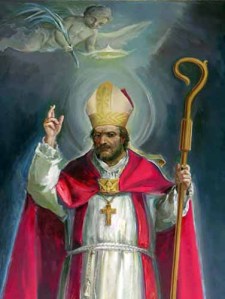
Saints Nicander, Bishop and Hermes, Priest, Martyrs
November 4
Roman Martyrology: At Myra in Lycia, in modern Turkey, Holy Martyrs Nicander, Bishop, and Hermes, a Priest.
A passio Metaphrastes not included in Menologion Simeon Logoteta, still unpublished, is the only extant document concerning these martyrs.
According to the news of sinassari Byzantine commemorating Nicander and Hermes, to 4 November, the first was bishop of Myra in Lycia, and the second priest ordained bishop by the Apostle Titus of Crete. There would therefore be in the first century. For their zeal to convert the inhabitants to the Christian faith, they were denounced to the governor of the city Libanius. They had them tie back of the horses broke into a gallop. Thus dragged to the ground, the Saints had all the skin torn wetting the soil with their blood. Later they suspended the easel, striking through a wooden board and they are exposed to fire. Since they were miraculously preserved from the flames, the tyrant ordered to plant their nails in the heart and guts. Still alive, were thrown into a grave and covered with earth. Martyrologies unknown to the medieval West, the two Martyrs were introduced to Licia always to November 4, from C. Baronius in the Roman Martyrology.
Author: Antonio Calisi
Source: Santi e Beati
 Leave a Comment » |
Leave a Comment » |  Bishop and Martyr, Canonized Bishop, Canonized Priests, Martyr, Martyrs Persecution, Priest and Martyr, Year for Priests |
Bishop and Martyr, Canonized Bishop, Canonized Priests, Martyr, Martyrs Persecution, Priest and Martyr, Year for Priests |  Permalink
Permalink
 Posted by naniam
Posted by naniam
November 3, 2009

Saint Libertine of Agrigento, Bishop and Martyr
November 3
The cult of St. Libertine
“The cult of St. Libertine had to start quite early, at the time of Gregory the Great, a praetor of Sicily and Sardinia had a bishop of that name, while in the life of St. Gregory, bishop of Agrigento, written by Leander, remembers a house that the Church of Agrigento had a very long time in Palermo and was called Libertino “was intact for a long time and was called the Church Agrigento Libertino. Read the rest of this entry »
 Leave a Comment » |
Leave a Comment » |  Bishop and Martyr, Canonized Bishop, Martyr, Martyrs Persecution, Year for Priests |
Bishop and Martyr, Canonized Bishop, Martyr, Martyrs Persecution, Year for Priests |  Permalink
Permalink
 Posted by naniam
Posted by naniam
November 2, 2009
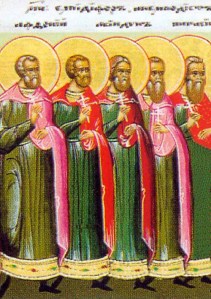
Saints Acindino (Acendino), Pegasus, Afton, Elpidiforo, Anempodisto and companions Martyrs in Persia
November 2 , † Isfahan (Persia), 341/345 approx.
The holy martyrs Acindino, Pegasus, Afton, Elpidiforo, Anempodisto and several of their companions suffered martyrdom in hatred of the Christian faith under King Shapur II of Persia, between the years 341 and 345.
Roman Martyrology: In Persia, the holy Acíndino, Pegasus, Afton, Elpidíforo, Anempodisto and many companions, Martyrs, who have suffered the passion has been handed down under the king Sabor II.
Source: Santi e Beati
 9 Comments |
9 Comments |  Martyr, Martyr of Persia, Martyrs Persecution |
Martyr, Martyr of Persia, Martyrs Persecution |  Permalink
Permalink
 Posted by naniam
Posted by naniam
November 1, 2009

A Plenary indulgence, applicable only to the Souls in Purgatory, is granted to the faithful, who devoutly visit a cemetery and pray, even if only mentally, for the departed.
A partial indulgence is applicable for the same any other day of the year.
All other requirements remain in effect, though really, Nov. 1 is on a Sunday. So is November 8. You’re going to Mass anyway. How hard is it to throw in another couple of prayers and make sure you go to confession in the next week or two?
In case you weren’t paying attention, the other requirements include:
Sacramental confession. One confession covers several indulgences; the important thing is to Confess within the next couple of weeks, assuming you haven’t just been.
Eucharistic Communion.
Prayer for the intention of the Sovereign Pontiff which can be as simple as Our Father and Hail Mary.
You must be free from attachment to sin, even venial sin. That’s the dicey one because I’m not quite sure what it really means; however, a partial indulgence is available for those who don’t make the cut. I have roses in the refrigerator and plan to bring them to my grandma’s grave.
I’m glad there’s another Sunday to do this on, as I have another cemetery to visit. You’d think it was my last cemetery run until Easter, but it won’t be. I’m a cemetery girl from way back, with a tradition of bringing or sending flowers for the departed’s birthday, one of which falls in December.
 4 Comments |
4 Comments |  Catholic |
Catholic |  Permalink
Permalink
 Posted by naniam
Posted by naniam
November 1, 2009
from Young Fogeys by
Fr. Jay Toborowsky
These all come from the Ignatius Press blog, so a thanks to them.
 Leave a Comment » |
Leave a Comment » |  Catholic |
Catholic |  Permalink
Permalink
 Posted by asimplesinner
Posted by asimplesinner
November 1, 2009

BENEDICT XVI’S PRAYER INTENTIONS FOR NOVEMBER
VATICAN CITY, 30 OCT 2009 (VIS) – Pope Benedict’s general prayer intention for November is: “That all the men and women in the world, especially those who have responsibilities in the field of politics and economics, may never fail in their commitment to safeguard creation”.
His mission intention is: “That believers in the different religions, through the testimony of their lives and fraternal dialogue, may clearly demonstrate that the name of God is a bearer of peace”.
BXVI-PRAYER INTENTIONS/NOVEMBER/… VIS 091030 (90)
 Leave a Comment » |
Leave a Comment » |  Pope, Pope Benedict XVI, Prayer, Prayer Requests |
Pope, Pope Benedict XVI, Prayer, Prayer Requests |  Permalink
Permalink
 Posted by naniam
Posted by naniam
November 1, 2009

Plenary indulgences for the Poor Souls in Purgatory are granted to the faithful who:
On All Souls Day, November 2, piously visit a church, a public oratory or — for those entitled to use it — a semipublic oratory. This is easy. There are plenty of Requiem Masses in my area, but even if that’s not true in where you are, there should also be Daily Mass as usual.
In visiting the church or oratory, it is required, according to recite “one Our Father and the Creed.” Another easy one as that’s included in Mass.
You must also pray at least one Hail Mary and one Our Father, or other appropriate prayer for the Pope’s intentions.
Communion must be received;
You must also go to Confession; and,
Have no attachment to sin, even venial sin.
 Leave a Comment » |
Leave a Comment » |  Catholic Piety, Church, indulgences, Mass, Pope, Pope Benedict XVI |
Catholic Piety, Church, indulgences, Mass, Pope, Pope Benedict XVI |  Permalink
Permalink
 Posted by naniam
Posted by naniam
November 1, 2009
 Blessed Theodore Romza, Bishop and Martyr
Blessed Theodore Romza, Bishop and Martyr
Veliky Bickiv (Ukraine), April 14, 1911 – Mukachevo, October 27, 1947
On the day when the Church indicates for us to contemplate the glory of all the saints, in communion with all of us on earth, in heaven already living eternal happiness, also used the liturgical feast of Ukrainian Romza Teodoro, one of the martyrs of the twentieth century Beatified by Pope John Paul II. He was born April 14, 1911 in the Carpathian region. After studying in Rome he was ordained a priest of the Greek-Catholic community in 1936. Returned to his diocese of Mukachevo, he became a bishop at only thirty-three. He bravely lived his ministry during very difficult years, between the horrors of war first and then the communist threat. On October 27, 1947 he was authorized to visit a church in his district. But in reality it was a trap, his carriage was struck by a truck and survivors beaten with iron bars. To be sure to kill him, the Bishop Romza was taken to a hospital where he was also poisoned. But the courageous testimony that he had left did not die: the years of persecution the against the Greek-Catholic community kept his memory alive.
Roman Martyrology: In the town of Mukachevo in Ukraine, Blessed Theodore Romza, Bishop and Martyr, who, during Prohibition of faith, responsibility for achieving the palm of glory for having preserved fidelity to the Church.
Source: Santi e Beati
 Leave a Comment » |
Leave a Comment » |  Beatified Bishop, Beatified by John Paul II, Catholic, Greek Catholic, Martyr, Martyrs of Ukraine, Martyrs Persecution, Ruthenian, Year for Priests |
Beatified Bishop, Beatified by John Paul II, Catholic, Greek Catholic, Martyr, Martyrs of Ukraine, Martyrs Persecution, Ruthenian, Year for Priests |  Permalink
Permalink
 Posted by naniam
Posted by naniam




 Posted by naniam
Posted by naniam 

















 MARIAN PRAYER OF SAINT GREGORY OF NAREK (A.D. 1010)
MARIAN PRAYER OF SAINT GREGORY OF NAREK (A.D. 1010)

 Blessed John Duns Scotus
Blessed John Duns Scotus





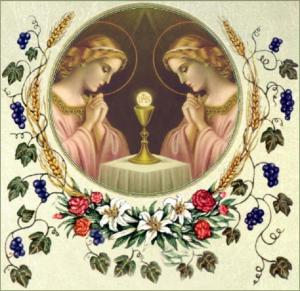





 Blessed Theodore Romza, Bishop and Martyr
Blessed Theodore Romza, Bishop and Martyr